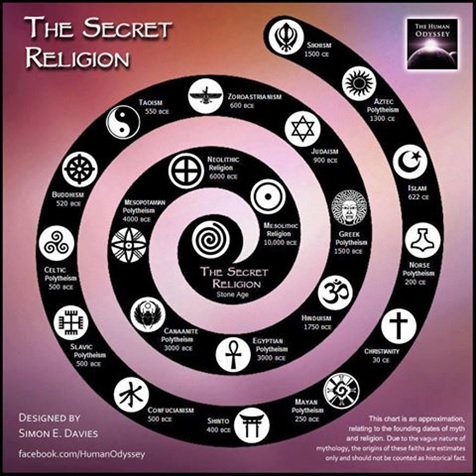
Do you, like me, feel there’s something important missing from these ideas on Myth & Religion? Several things, I think.
Can you help me name them? Can you say how you feel reading these words? I am fascinated, yet feel like something’s been taken from me. A little girl kinda feeling.
“The world is full of religions systems that for thousands of years helped shaped our beliefs and world views. Over the centuries, many of these creeds have passed into the realm of mythology (e.g. Greek and Slavic polytheism). Yet in their day, these ancient religions were worshiped in the same manner as Christianity and Buddhism are today.
Mythology is simply the memory of an old religion that’s no longer practiced (although many are starting to be resurrected and worshiped once again – e.g. Paganism and Norse Heathenism).
In many cases, our modern religions evolved from much older systems, such as Norse mythology from indo-European, or Judaism from the Canaanite faith. Like the branches of a tree, these distant faiths can be traced back to a single origin, which I have called ‘The Secret Religion’.”
~ Human Odyssey
Image by Simon E. Davies
Not too long ago, I was asked by a friend to comment on the image included above. In short, was it accurate?
Why is it that I always feel like I am raining on someone’s parade with these things?
Anyway, for those of you curious as to my response, the short answer is no, it is not accurate. But for the sake of easy accessibility, I will try to be succinct.
Firstly, this diagram places all these multi-variant traditions into a single chronological (and implied evolutionary) line based on their dates of origin. This is problematic because “dates of origin” in most religious cases are highly arbitrary (and not always correct). Despite their caveat on approximation, all of these traditions stem from earlier religious traditions and have been influenced and modified based on traditions/cultural circumstances they came in contact with over long periods of time. The implication that any one of these traditions is somehow “set” at any given time or place or that they all derived from a single, central, source is not supported by cultural or archaeological evidence at all.
For example, the root belief systems that gave rise to Hinduism/Jainism/Sikhism are the not the root systems that gave rise to Zoroastrianism, Shinto, or Christianity (though many of them had contact with one another at different points in time). Global religion works, and has often worked in the past, more like a complicated, interconnected, mosaic and not as a slow march in any one direction or another from some unnamed mystical source outward. Even more unfortunately, this entire diagram deeply smacks of Victorian Hyperdiffusionism. Back in the days of Frazer and his infamous Golden Bough, it was popular among academics and pseudo-intellectuals alike to engage in “single sourcing.” Meaning, they were often in search of one mystical origin point from which all other beliefs and practices were thought to originate (related, somewhat, to the Biblical story of Babel). One of the main problems with Hyperdiffusionism then was its dedication to an idea of cultural evolutionism where white, Western, Victorian society sat on the top and everyone else was positioned in a descending line from civilization to savagery. Now, the image above isn’t particularly dedicated to an assumption of white, European, supremacy; it is, however, interested in putting particular groups of people on a religious pedestal and in romanticizing “ancient knowledge” to whatever anti-modernist ends. (Side note: Threads of Victorian Hyperdiffusionism seem to be quite prevalent within the modern Pagan and New Age movements in general. These ideas also continue to permeate throughout various conspiracy theory groups, especially in terms of Ancient Aliens and Atlantis narratives which still posit a “single source,” albeit an extraterrestrial one, for all of ancient human civilization.)
Third, mythology is not simply a “memory of an old religion that’s no longer practiced.” Mythology is affected by numerous complicated cultural processes and exists as solidly in the present day as any other cultural notion (and continues to transform and change). Finally, the statement that “these distant faiths can be traced back to a single origin, which I have called ‘The Secret Religion'” is a nice sentiment, and it appeals to a wide variety of people because it feels simple and easy to understand, but the author has absolutely no evidence for this other than that ‘it seems right.’ He/She loosely draws vague connections between past and present faiths that they state “are worshiped in the same manner.” This betrays their ignorance of how these belief systems actually work and serves only to promote their idea that there is a single “secret” source. The author gives no attention to similarities in cultural processes (as opposed to cultural objects) which are more often the reason for apparent similarities and they seem to consider religious traditions as autonomous bounded entities with no variation over time, place, or people.
I’m sorry, but it just doesn’t work that way.
Golly. Where did you amass all this info from? No rhetorical. It must have been from dozens of places. I came across you on a Facebook site and was intrigued to read the black birth of so many-many religions. So many…I never knew. Is there any way of downloading a screen shot or paper copy, so that I can read it? I’m sorry I’m a bit of a dinosaur with this whizzy stuff and it is too blurred to read. You must have spent years and years accumulating more and more info, before putting it all together. Did you have time to breath, eat, work or play? Or was this a Life’s work? It is amazing! How come we have never heard about you and your work before now? So many questions, sorry. (You ask I now see, for my web site…my what? I don’t have a web site, it’s just me, sorry.)